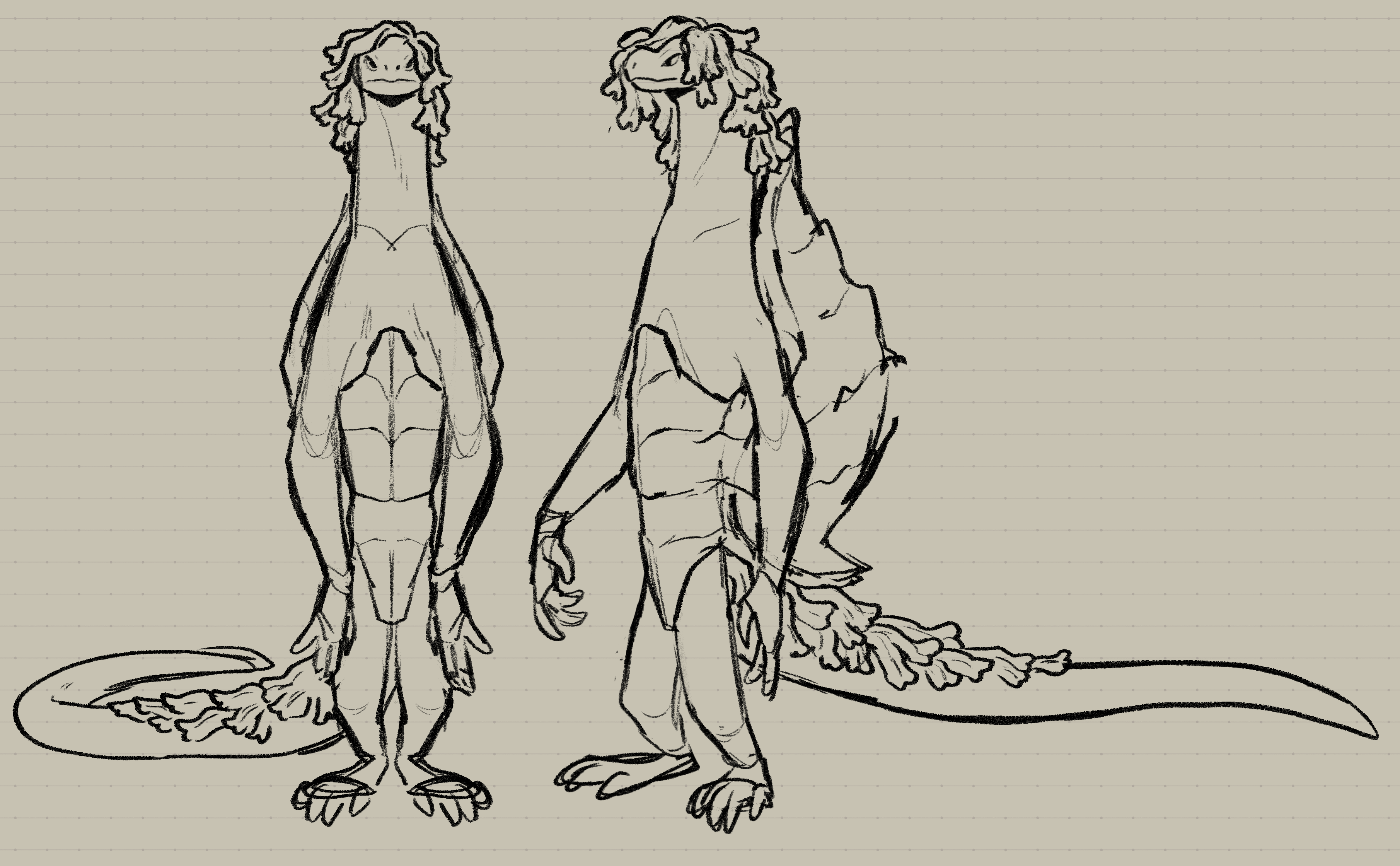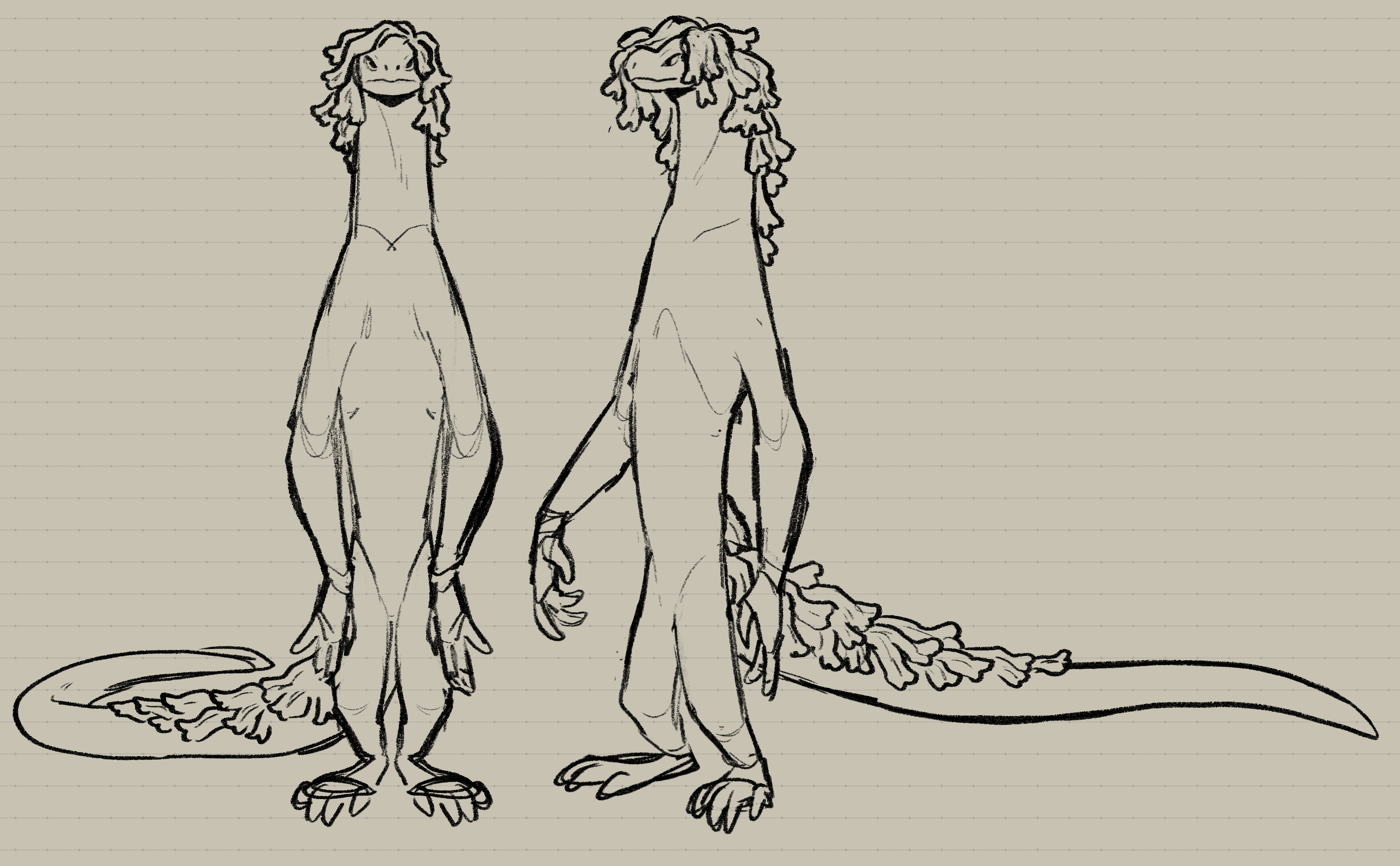Tajira are a semiaquatic species, travelling from their original island into the ocean and reaching other beaches. They're nomadic, but often keep themselves in a designated territory, of which the size varies. They're a large-sized biped with a long hydrodynamic body, tail, and a mane sprouting from head to tail. Their skin is composed of scales, usually smooth but sometimes keeled or sharp. They have two nostrils on the tip of their nose, needing to resurface to breathe when underwater. They have long necks, which can retract into the body. Their shells are not part of their body, merely an accessory.
Their hands and feet have four clawed fingers, with adhesive pads in their hands helping with grabbing and dexterity. They have a mix of a plantigrade upwards walk and a quadrupedal gallop on land, with more elegant locomotion on water. They are omnivores, with a diet composed primarily of fish, crustaceans and algae, but other food sources can be included.
Physiology Notes
Head
By and large, Tajira heads are long and blunt with small beak protrusions. Longer, shorter and different shapes of head structure are common to see, and sometimes their snouts can be elongated enough to look like nostrils, which aids in reemerging to breathe.

The difference between a blunt snout and elongated snouts.
Eyes & Ears
Tajira eyesight is adapted to underwater, with special lenses adjusted to refraction underwater and more sensitive to violet from yellow, giving their eyes a more spherical format. In land, these lenses retract and leave Tajira with an average vision, though they are somewhat nearsighted. They are sensitive to ultraviolet and consider it a special color. Their eyes can have different shapes and colors, but the effect is purely visual, as their eye membranes work the same regardless of their appearance.

Left: A collection of some eye shapes and patterns found in Tajira. They have prominent eyelashes.
Right: Tajira eyes become enlargened as their eyelids retract when underwater. Commonly called unsettling by other species.
Tajira lack outer ears, but have an ear canal hidden between scales, which can become visible if expanded or manually stretched. While the wavelength range they can hear is on the average with a tendency for lower frequencies, they're great at identifying lower volume sounds without strain.
Mouth

Left: Diagrams of a Tajira mouth, showing teeth retracted and expanded.
Right: Two Tajira fighting, teeth showing.
Tajira have sharp, serrated retractable teeth. Their main function is for combat, puncturing and ripping through the skin, but also serve as a way to quickly kill small prey with a fatal bite. Otherwise, teeth are kept retracted and hard food was torn with the jaw itself or with the use of hands and tools. Their teeth only grow once, the gum closing up once a tooth falls. Modern usage of teeth after the advent of cooking and eating utensils has dropped for Tajira, being an aesthetic thing for most.
They have thick, forked tongues with a rough texture. The forked ends are vestigial, having no function for Tajira and some are born without these ends. Their taste buds lack receptors for saltiness, as most of their diet consisted of extremely salty food that would be unpleasant otherwise. They have better receptors for sweet and umami tastes, particularly sweet. Individuals of other species who enjoy sweet food are often called "Tajira tongued".
Nose
Tajira nostrils are adapted for underwater swimming. They can inhale and hold large amounts of air, before diving in. When resurfacing, they'll expel ingested water and excess salt via sneezing, keeping their internal saline balance intact.
Their olfactory receptors work both in land and underwater, re-calibrating itself due to water physics and how it alters scent. They can smell rain and the concentration of salt in water, which indicates how regularly they should expel salt when resurfacing.
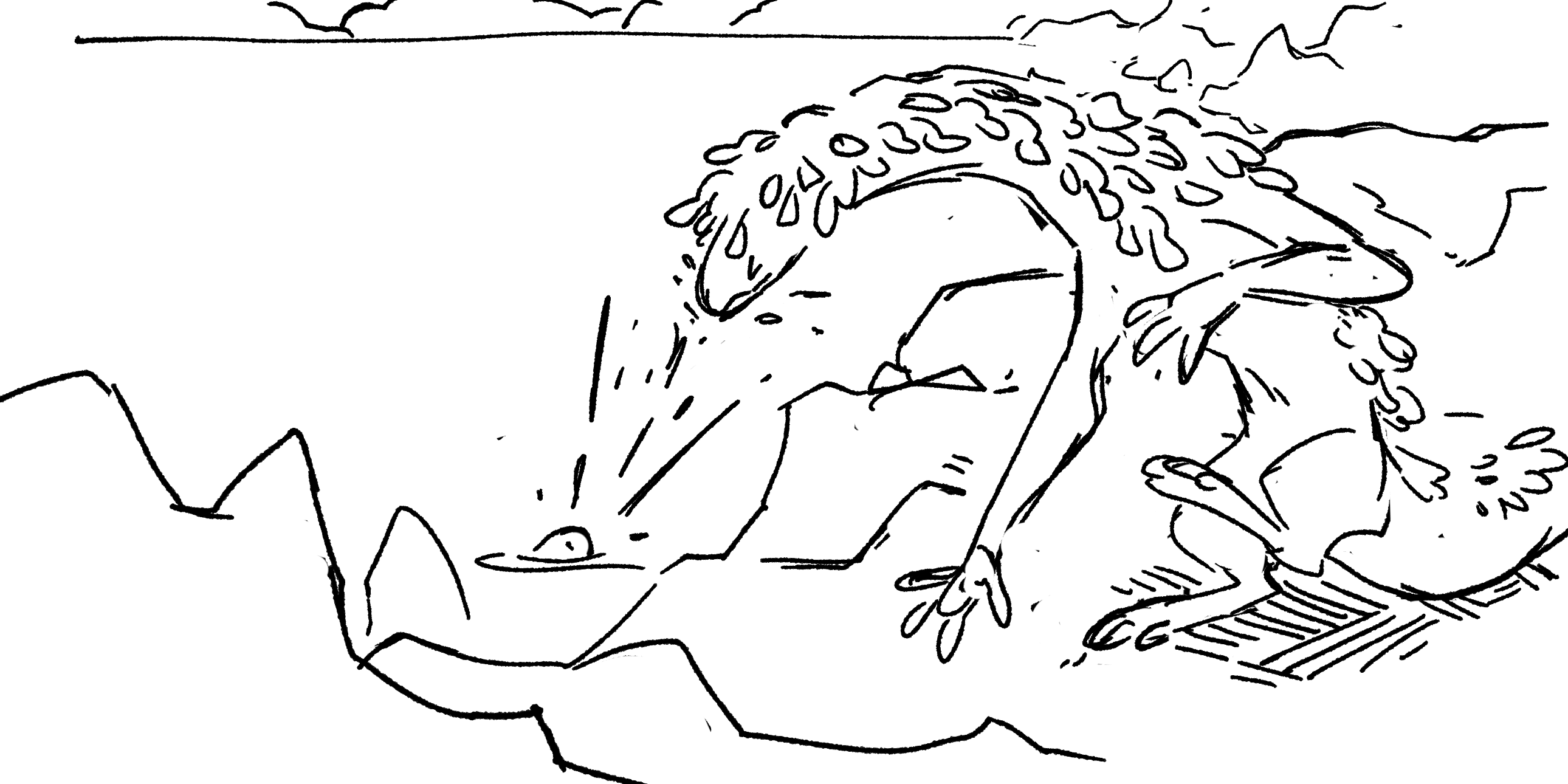
A Tajira sneeze hitting another bystander Tajira.
Body
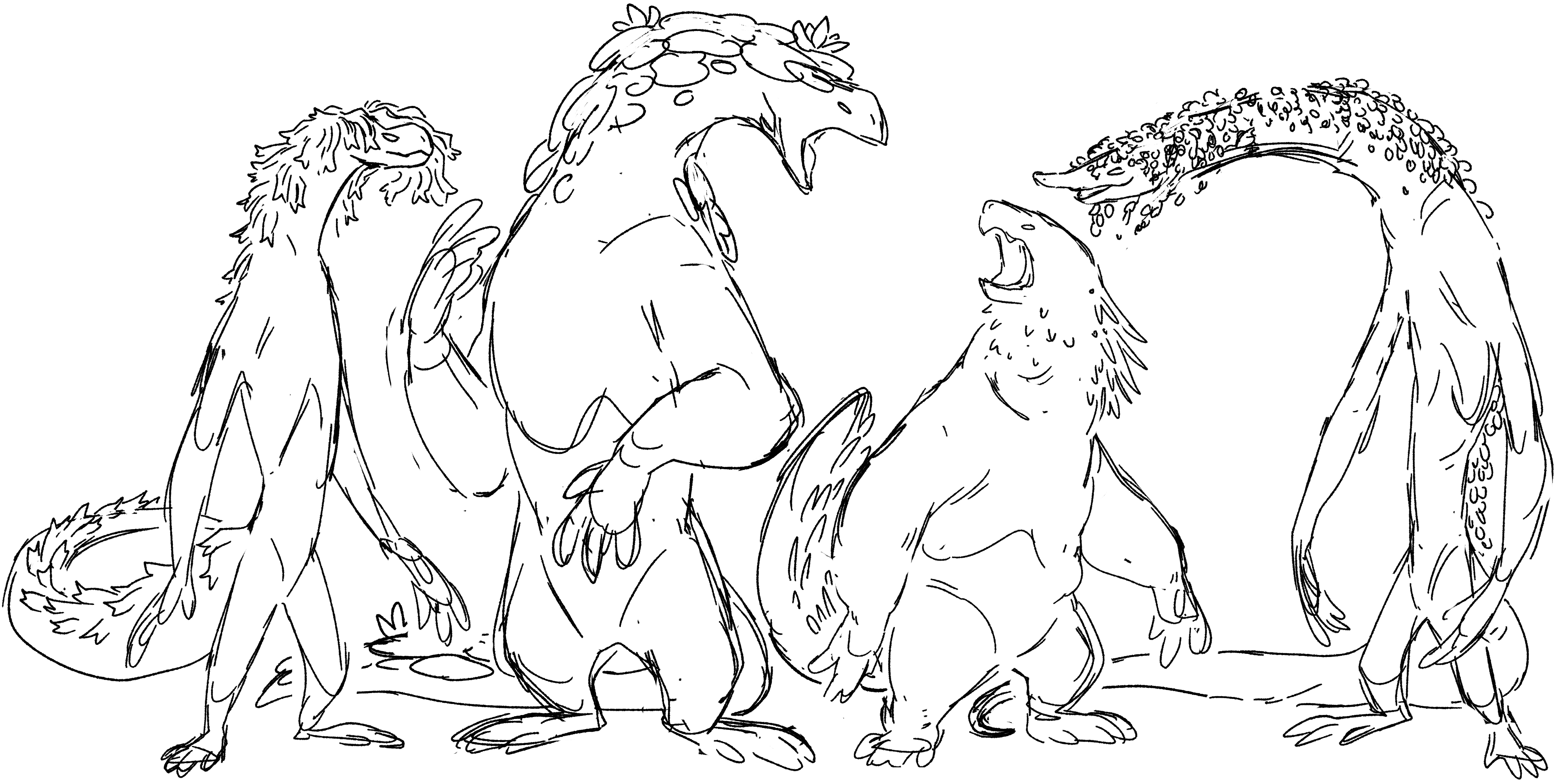
A small glimpse at the range of Tajira body types.
Tajira size and builds are diverse, with fat, muscle mass and height based on lifestyles and genes. Tajira have a harder time building visible muscles than other species, but muscular individuals still exist. Their proportions stay consistent, with very elongated body parts except for legs and feet, which are stout and arms longer than the torso.
Limbs

Top: Tajira hands with the adhesive pads highlighted
Bottom: Arm position when swimming.
Tajira arms start with their shoulders sprouting from their collarbone right below the neck, reaching all the way to their thighs. Their arms are strong and hypermobile, helping them reach out for items in faraway places and crevices both inland and underwater. When swimming, their arms rest glued to the body to keep a hydrodynamic silhouette. Their hands are long, and their fingers have a claw-like structure with hard keratin. As to make dexterous usage possible, their palms have adhesive pads which are used for precise and nuance positioning of items instead.
They have very short legs and a plantigrade stance. Due to their proportions, the natural position when walking and running is tipping the body forwards, using the tail to balance themselves. Their hips adjust to the motion, keeping the legs perpendicular to the ground. Their run is quadrupedal, using their arms to "push" the lower body forwards, spine curving. They struggle with balance in a bipedal run and will often trip. Their speed is low, only reaching 3.5 km/h and not having great endurance for long distance runs.

Left: A walking Tajira.
Right: Running Tajira, using their arms to fling their body. This running style is more balanced, but still awkward.
Tail
Tajira tails are very long, from only slightly shorter than their torso to almost 50% longer. They are very important for swimming, and Tajira with shorter tails may struggle with movement underwater. There are two classification of tails: whip and flat.
Whip tails have thick bases and thin out at the end, sometimes creating a whip-like look if the size difference is drastic. Despite the name, they have a slight flatness to them, being vertical instead of horizontal. Tajira with whip tails will swim left and right to gain momentum. They can be used as a weapon by cracking their tail into foes.
Flat tails have spread out thickness, with the end being flatter than the base of the tail. Tajira with flat tails will gain momentum by moving up and down, sometimes only moving the tail instead of the entire body.
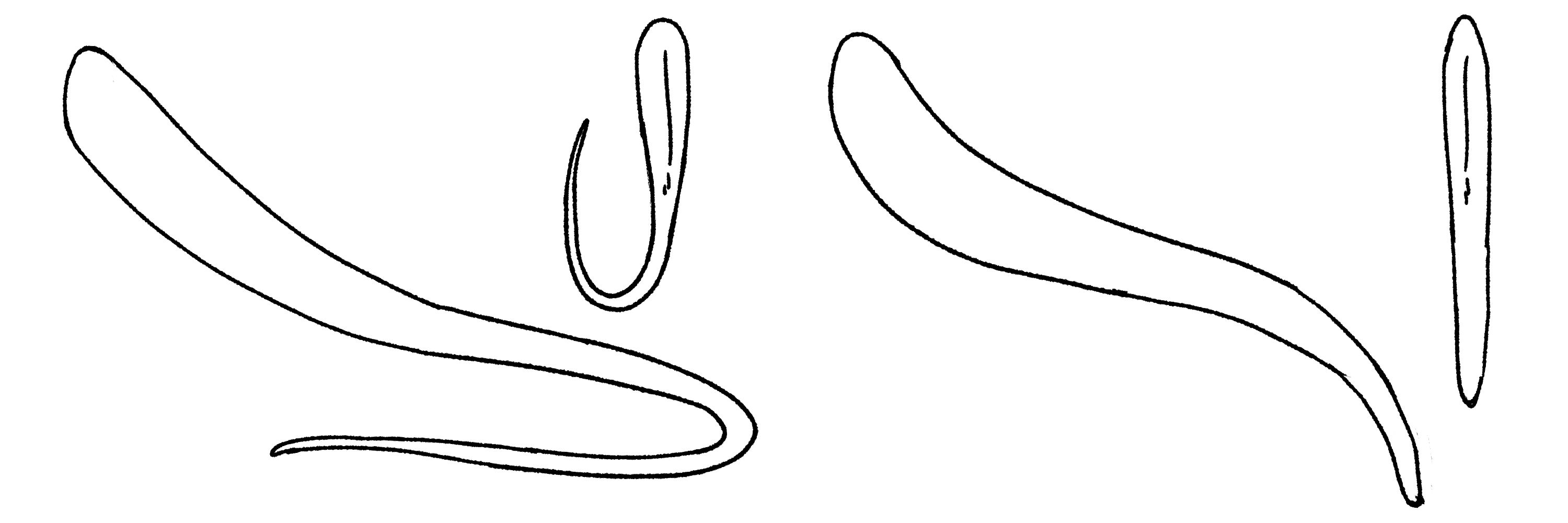
Whip tail and Flat tail respectively.
Other than swimming, their tails are essential for balance inland, keeping their long body stable when moving. While the specific movements differ depending on the tail, their swimming is otherwise similar: They'll make use of their body shape to gain speed underwater, kicking with their legs and tail to speed up. They have a smooth, fast swim style and can reach 15 km/h on average and 36 km/h in short bursts. They can easily control their direction, reposition themselves and dive in or jump out of water. When tired or resting, many will float belly up or down, keeping their nostrils above water.
Aether
Tajira possess natural Kusho Aether. It is the source of their manes, made out of plant-algae and other flora. They sprout from the dome of the head, following their neck, spine, all the way to their tail. As it made of Aether, these plants have different compositions from real species, and are connected to the Tajira themselves.
The main function of their manes is for camouflage in areas with dense flora and Aether photosynthesis. They will collect Aether in the surrounding area to keep their Aether glands filled and help with other body functions, such as extra energy sources, wound healing and maintaining internal structures. The longer the mane, the better it is at both of these functions, but trimming is required as to not become a hindrance in movement. Modern Tajira style their manes in various ways, as the camouflage benefit is no longer useful and photosynthesis has diminishing returns after a certain mane size.

Left: Range of mane roots (colored in grey).
Right: Examples of mane appearances, with various flora being copied.
Reproduction
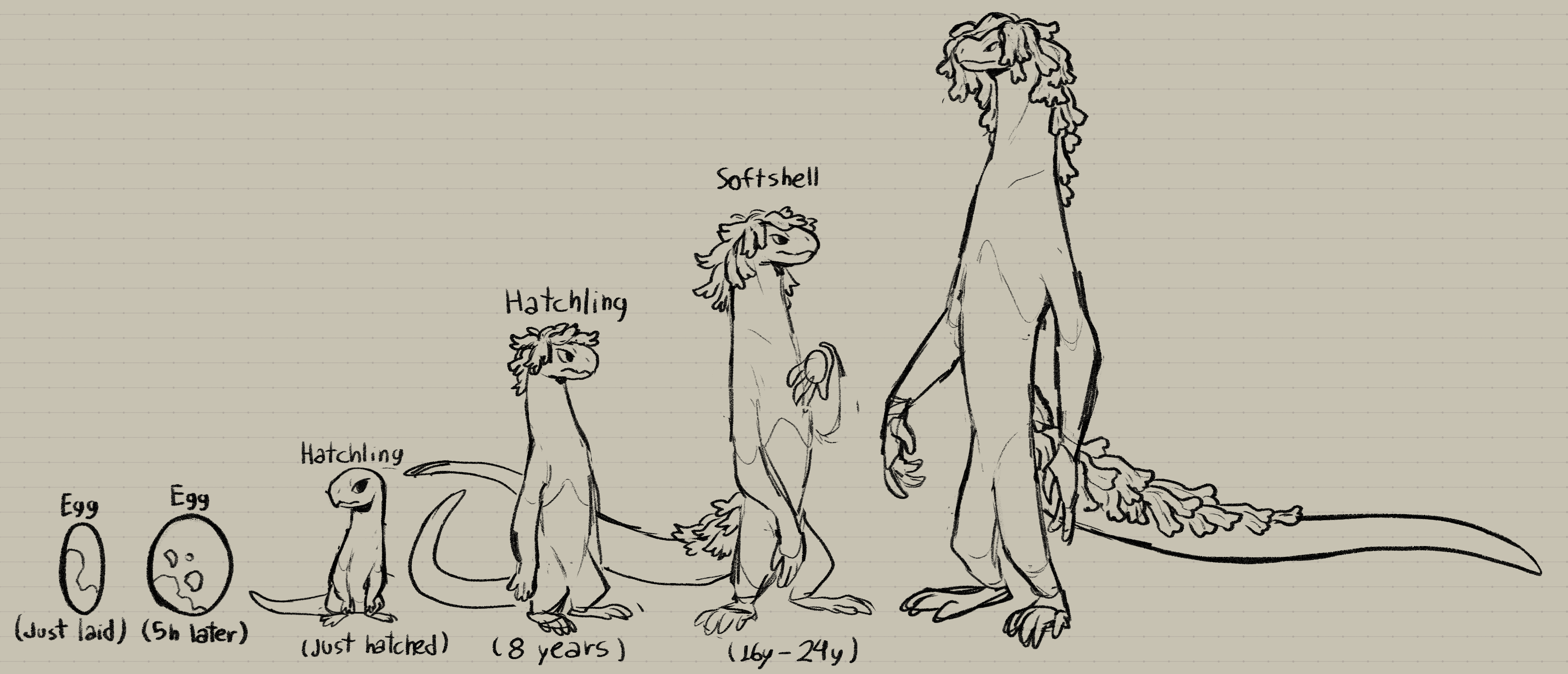
The development cycle of a Hanasei, to scale.
Egg
Tajira reproduce sexually and are intersex. They have no breeding months and lay eggs every month, though without insemination these eggs are infertile (also called "empty") and will be sold or eaten to regain nutrients. Tajira can close their reproductive canals, meaning fertile eggs are rare even if they have sexual partners. When reproducing for children, the larger individual will usually be the dam.
An egg will take around 2 months to develop within the dam, and after laid it'll take around 4 months to hatch. The egg comes out in a long, ovoid shape, and after a few hours it expands into it's normal round shape. The shell is rough and sandy, but not very thick. Embryos already have sharp beak protrusions, which help them break the shell.
Hatchling
After hatching, babies are labeled hatchlings. They already have a few skills when born and a degree of independence, being able to walk and swim around, although with less skill than older Tajira. They have the mental intelligence of a 4-year-old.
Their growth both mentally and physically is slow, and Tajira will be considered hatchlings until 15 years old. By their 6th year, their manes will start growing, and they'll start to have proportions similar to adults. Their tails grow faster than they do, leading to awkward walks and growth pains.
Softshell
On their 16th year, hatchlings grow into softshells. Their manes will have expanded, and their tails will slow down growing, allowing the rest of their bodies to catch up. They have the mental intelligence of a pre-teen, and will grow into an adult in 8 more years. They reach their max height at around 23 years old, and adulthood in their 25th year
Arts
Visual arts
- Tajira arts often focus on the creation of clothes, ornaments, tools, boats and other artisan professions, while visual arts are less popular. However, as a niche skill it heavily emphasizes the uniqueness of a Tajira's work, and custom portraits have high value in a home. The most popular styles tend to be ones that shift away from realism, as replicating real life is seen as uninteresting and lazy, but there are no consistent trend or movements that can be tracked, rather individual artists and their popularity.
- Sculpture is even less popular than other visual arts such as painting, due to price of materials and lack of space. The main sculpture movements come from imported Hanasei sculpture pieces, which have a small market niche, but no major appreciation.
Literature
- Tajira literature is grandiose. Many of the most popular works are epics, with narratives that spawn fantastical worlds with heroes, villains and fight against gods. How a character carves a name for themselves, their story and impact all are part of the writing style of the Tajira epic. Sometimes, the story will be about the fall of a hero instead and the tragedy of being forgotten.
- Settings won't always be in Koegama. New worlds, or at least new seas and countries will be created, all with new rules to play and advance the plot. Unique worlds garner interest, but worldbuilding isn't a necessity as much as it exists for the character's sake.
- Despite the grand narratives, the size of works tends to be short. Longer stories will consist of various bite sized volumes, which are easier to distribute and sell. Readers will finish faster and talk about the topic earlier, and the segmented nature of volume releases avoids binges and creates hype, which is essencial for authors who want to make it big. Writers more interested in personal growth are more likely to write longer works.
- Non-fiction works are often auto-biographies, detailing the accomplishments of the author. Post-mortem diaries are even more popular, especially from famous Tajira.
Architecture
- Tajira are a seafaring society, and spend most of their time in their boat. Thus, most architecture is related to boat designs and types of boats, with the most popular having a few rooms and piloted by one individual.
- Shopkeepers will either have a separate boat for their shop, connected to their main boat or a larger shop boat, with multiple compartments for personal and the shopfront, cargo and others. The difference other than size isn't big, and falls under personal preference of the owner.
- However, buildings are still constructed in land. Docks, boathouses (a boat storage building, not to be confused with a house boat), inns, warehouses, most constructions exist to facilitate shipping and storing goods, restocking and hosting Tajira. Many docks are positioned so that boats can open shop and services all around, thus making store buildings less common.
- Buildings sit on elevated platforms. They are long and have many open, tubular structures, similar to fish markets and bazaars. They are made of wood, covered with water resistant coating. Metal isn't common as most of it gets corroded by the sea breeze, especially as Aether speeds up chemical reactions.
Transportation
- The boats Tajira live in are their main method of transportation, giving them immense freedom in the sea. Tajira will jump onto the water and swim over another boat to meet someone, and link their boats together until their meeting is done.
- For faster water travel, high speed ships of larger size will travel with a dock attached to it for smaller boats to reside. Depending on the model, bullet ships can carry up to 30 medium sized boats.
- Land travel is slower: carts are used to connect any inland resource -- such as farms or mines -- and carry the cargo back to shore capitals. Tajira quickly adapted and added Hanasei high speed rail for travel and transport to fix their deficiencies in ground travel.
Clothing
- Tajira have a very fashion-forward culture. Dressing up is one of the easiest ways to showcase your individuality, and creating your own outfits reinforces their societal values while being entertaining, though most still buy pieces from tailors, jewelers and such. Dress up get-togethers are a popular way of bonding with friends and learning each others' styles and preferences.
- A set of three close-fitting collars enveloping the neck are a very common fashion item. Collars come in many styles, from beaded metal, chokers with encrusted gems and metal rings, to less popular styles that may be one of a kind. Often, the base collar -- which sits lowest at the neck -- will have extra flairs. Luminae-style collars will be woven instead and have tassels and other traditional patterns, even if made by a Tajira.
- Headgear is popular in the form of hats and masks. Hats are tied on the chin and tend to have a flat base where ornaments will sit on. Styles vary, from crowns to geometric shapes, with the Tajira's favorite animals, flora or locations being represented in some way.
Masks can be worn similarly to hats at the top of the head or covering the face -- sometimes the lower jaw is left visible. Imitating folklore mythos, animals, monsters is common, and sometimes a Tajira will create their own unique creature for their mask, giving it a name and a meaning. - For the body, shells are a very popular traditional item. The shell front can be made into whatever they wish for -- though one must account for material weight and how easy it is to get around with it -- and with whatever colors they want. A rather skilled Tajira may create various shells to wear at different occasions.
- Clothing is another option for the body. Most have a seafaring style that is looser and more open, making it comfortable to move around and contrast the heavier, more ornate accessories they wear. Coats that are buttoned or tied with string, pants with a baggy look that taper at the end, and many pockets and bags. Fancier styles may add extra layering of fabric and leather, gold filings and ornaments. The modern wave of clothing has been heavily inspired by traditional Luminae weaving.
- Outfit and pattern symbolism comes from the individual and what their choices mean to them. Very few articles come with imbued symbolic meaning, other than pieces worn for religious or work reasons.
Music
- Most of Tajira oldest songs are acappellas and shanties, sung to distract and entertain fleets. Acordeons, small string instruments and percussion carved from fruits and filled with metal pebbles have been included in songs as time passed. Lyrics talk about work errands, difficulties, and the after work festivities.
- Modern song lyrics will talk of larger than life adventures and heroic characters. Creating new narratives in song is just as common as doing so in writing. Sometimes, these narratives are retellings of their own life, embellished with extra details and events. Singing about a life you wish you had or plan on having is also popular.
- Songs tend to follow specific rhythm patterns -- originating from the rhythm of menial labor but later adopted into Tajira music theory as patterns with their own meanings. Songs following uncommon patterns or going off chart fall into more rebellious or anti-mainstream genres.
Cuisine
- Much of Tajira's food sources come from fishing. Many boats come with compartments to store fish and fishing equipment, and learning to fish and prepare seafood is an essencial skill taught from early age. Fishermen travelling near Hanasei settlements would trade their catches with the locals, the first source of river and lake fish to Tajira, which mainly reside in seas and oceans.
- Alongside fishing equipment, boats will have small gardening rooms to cultivate plants. Most are aquatic, but land based plants are becoming more popular in cuisine for their high nutritional value and staving off sicknesses their lifestyle brought in. Their seeds are more expensive and harder to acquire.
- Tajira don't have a track record of domestication, and the few species they have domesticated do not serve food purposes. However, their large trading webs supplement them with Luminae and Hanasei agricultural products, which are very sought for and became hot items in dock markets.
- Some Tajira will focus on farming work and live closer to shore to acquire and sell artisan goods, animal products and plant produce. While a major change from the culturally expected lifestyle, the influence of Tajira living in mixed species cities instead of seafaring and the larger profit margin makes this a more attractive option for newer generations.
Language
To be written.
Names
Tajira are born with one name, given by their parents. As they age, they will add extra words to their name relating to things they accomplished and did. Adding these names randomly is frowned, and someone who is doubting your abilities might challenge you to prove you deserve your name.
- Birth name: Commonly a quality or good thing to have. The equivalent of naming a child "Valor" or "Power". More artsy parents may shove two terms in one name, sandwich the term between two syllables ("Emvaloras" for Valor, for example), or corrupting the term by changing, removing or adding letters ("Vlorr" for Valor).
- Extra names: Often very short, placed at the end, but some prefer putting at the beginning or even in the middle of their birth name. There are various sources to gain extra names. Some places and professions have unique terms based on their region, but some generic ones are:
- Gry: Higher education graduation.
- Mor: Opening a shop or a service.
- Clk: Building a boat.
- Psh: Gaining large renown (a name given by other Tajira, and not applied by yourself).
- Hrr: Seasoned traveler (the requirements for this are debated and fought over due to being vague)
- Sounds: Many clicks, trills, growls and rumbles, which end up written as GR, KHR, CLK, HR, PHR, and RHT. Consonants sounds are P, B, H, N, and Z. Vowels are limited and some may not even have them, but the most common are A, E and Y. Sounds are separated with a ' to denote growls and clicks versus vocal sounds.
Uncommon sounds are L, V, O, U and T.
Examples: Gr'erhen, Phr'halann'psh, Naa'Hrr, Morean'clk'pah, Hrr'Ninmuyn
Society
- Tajira heavily favor personal choice and uniqueness: everything from what you wear, how you act and your name. Many of their societies focus on a meritocratic hierarchy system: Hard work will bring you recognition and fame, which come with a lot of societal power in a society with no major governing bodies, while being unknown can make it hard to stay afloat.
- Tajira society tends towards individualism, focused on the self. However, one must not conflate individualism with lack of communities: Tajira will live in fleets spanning from 2 to 30 and more boats. Members inside the fleet will trade goods and services between each other through bartering systems or at discounted rates and offer support more often than Tajira outside of the fleet. Their individualism is malleable and context-dependent, and will extend to their fleet mates and anyone in the "in-group".
- Tajira are free to join and leave any fleet on paper, but depending on the fleet tactics such as ostracization, economical and communal pressures are used to kick out or stop a member from leaving. Larger fleets will have contracts for membership which can make departures a difficult process.
- The labor composition of a fleet is very dependent on conditions and members who join. Tajira who work in areas that a fleet lacks will be more sought after than repeat workers, and fleets will have contracts and trade agreements to access goods and services they lack. These agreements are constantly changing and fleets will fight over better terms for themselves, and larger fleets can bully smaller fleets into bad contracts.
- The economy of Tajira runs on docks and market spots, where fleets will station and sell their services to various other fleets or dock resellers -- who mainly live on land, buying goods from fleets, stocking and reselling to other fleets. Buying from other fleets tend to be cheaper, even if there's no economical contract in place, but each fleet will have their schedules while dock resellers are available at all times for higher prices.
- Piracy is a common issue in society. Pirate fleets will take control of trade routes, waterways and demand fees to access them. Certain docks may be taken by pirate fleets, which ask for fees and part of the products before someone can set shop. Less business savvy fleets will rather plunder and hunt down other fleets and docks, and resell those items instead. Many are born in the black market, where those stolen goods are found and services such as hitmen, hunters and bribers are available.
Age
- Tajira hatchlings are very independent from the start, but take a long time to develop physically and mentally. They can walk, swim and forage for food and have self preservation skills, but they must stay with adults for a long time to learn other skills such as language and education. Most Tajira are home-schooled.
- From pre-teen years (16 years) until adulthood, Tajira are called softshell. At that age, education deriving from their parents will end and they are expected to start deciding what to do when it comes to apprenticeship, education and jobs. Parents and fleet members will give advice, but not decide for them. Many start saving money or learning how to build boats, preparing to move out.
- When a Tajira becomes an adult, they are kicked out from their parents' boats a month after their shell making ceremony, and are expected to support themselves. Most young adults go to larger education institutions or trader schools, and some will even leave their home earlier as they have no age restrictions.
- Tajira don't separate their adult life stages, but anyone over 150 is considered an elder. Tajira age more gracefully than other species, and its rare for them to retire, especially since they must pay for their retirement with savings or use their renown to gain benefits in their fleet.
Customs and Celebrations
- Despite not needing nests and hosting eggs in rooms, Tajira still build nests as tradition. Each nest will hold a single egg, and it's common for various trinkets to be scattered across. Some are gifts for the child, others are symbolic and represent the parents desires for the child's health, personality, and even colors and hair type. No sharp objects are placed, so hatchlings don't hurt themselves if moving out of the nest.
- Young Tajira are not allowed to make their own shells, and will wear simple models for all of their childhood. Once a softshell hits 25 years old, they will perform a rite where they must make their first personal shell. This is a passage to test their independence, and what they can do by themselves versus what they will need the help of the community on. The steps are separated into design drafting, material collecting, shell making and then decoration, and at least two of these steps must be done with no outside help. Once the shell is finished, they must wear it for a day as they celebrate with others their adulthood.
- Collections are an important part of Tajira's individuality. One will create, find and buy various items to create small collection shrines on their homes. These collections can be of a favorite animal, object, or just represent various things the Tajira enjoys.
- Once a Tajira dies, their body is stored in the boat, which is burned at sea. Any collections or personal items are burned alongside the boat, an old practice to avoid thieves and pirates from plundering ghost boats.
- Fleets will often be named by the first individuals who create it, but a fleet is named whatever it is most called. Notorious fleets will have titles and euphemisms associated with them.
Politics
- There are no major governing bodies in most Tajira societies, with contracts, arguments and rules being made per fleet, per dock, per trade sea lines. As such, politics will be pushed by individuals within a group who wishes to better their position.
- The more influence a Tajira has, the more likely they can pass new rules and change the social contracts. However, pushing beyond what your name secures can lead you to being ostracized or kicked out of the fleet.
- Larger fleets will have leadership positions, as influential Tajira accumulate enough social capital to start making the rules. These leaders can be challenged with group dissatisfaction and fleets breaking off, or more violent methods with mutinies and assassination attempts. They tend to develop very complex meritocratic hierarchies and begin structuring concrete systems to follow, compared to the more anarchist system of smaller fleets. Crisis of succession are common in a newly formed large fleet, and cause many to not survive beyond one generation, fracturing.
- Fleet merges happen with fleets that have large trade histories and start trading culture. When the fleet mates start extending their bubble to include a separate fleet, the fleets are likely to combine. These mergers are often the beginning of a larger fleet.
Religion & Beliefs
- Tajira are very superstitious, and many occult beliefs run deep in their communities. One of the most popular is mane occultism: The flora the mane mimics, shape, growth pattern, colors and other qualities of the mane influence your love life, luck, compatibility and opportunities in jobs. Occultists will run fortune predictions through various methods: taking mane pieces and boiling them with fortune herbs, incense burning and meditation, and mane eating.
Reincarnation
- Organized religion with gods don't spread far, and many religious sects are small and confined to the region's fleets. However -- and even if a Tajira already believes in a religion -- many subscribe to reincarnation, and that the more power and renown you cultivate, the more your soul will grow. If a Tajira's soul becomes complete, they will break through the reincarnation cycle and reach higher enlightenment, where they will have enough power to create their own world. However, Tajira who fall behind or fail to rise will shrink their soul, trapped in the reincarnation cycle.
- As enlightenment makes you a god, breaking the cycle and creating Koegama is the backstory of many other religious gods in Tajira religions, and even those who convert to religions of other species. It is an additive belief.
- Only those who are "sentient" are trapped in this reincarnation cycle, meaning the sapient species of Koegama. All other living beinga are not beholden to these rules, and for those who believe in gods alongside reincarnation, they believe they were created to fill Koegama for the sake of the god's children and believers.
